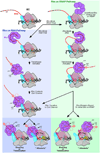Bacterial transcription terminators: the RNA 3'-end chronicles
- PMID: 21439297
- PMCID: PMC3622210
- DOI: 10.1016/j.jmb.2011.03.036
Bacterial transcription terminators: the RNA 3'-end chronicles
Abstract
The process of transcription termination is essential to proper expression of bacterial genes and, in many cases, to the regulation of bacterial gene expression. Two types of bacterial transcriptional terminators are known to control gene expression. Intrinsic terminators dissociate transcription complexes without the assistance of auxiliary factors. Rho-dependent terminators are sites of dissociation mediated by an RNA helicase called Rho. Despite decades of study, the molecular mechanisms of both intrinsic and Rho-dependent termination remain uncertain in key details. Most knowledge is based on the study of a small number of model terminators. The extent of sequence diversity among functional terminators and the extent of mechanistic variation as a function of sequence diversity are largely unknown. In this review, we consider the current state of knowledge about bacterial termination mechanisms and the relationship between terminator sequence and steps in the termination mechanism.
Published by Elsevier Ltd.
Figures






References
-
- d'Aubenton Carafa Y, Brody E, Thermes C. Prediction of rho-independent Escherichia coli transcription terminators. A statistical analysis of their RNA stem–loop structures. J. Mol. Biol. 1990;216:835–858. - PubMed
-
- Ermolaeva MD, Khalak HG, White O, Smith HO, Salzberg SL. Prediction of transcription terminators in bacterial genomes. J. Mol. Biol. 2000;301:27–33. - PubMed
MeSH terms
Substances
Grants and funding
LinkOut - more resources
Full Text Sources
Other Literature Sources

